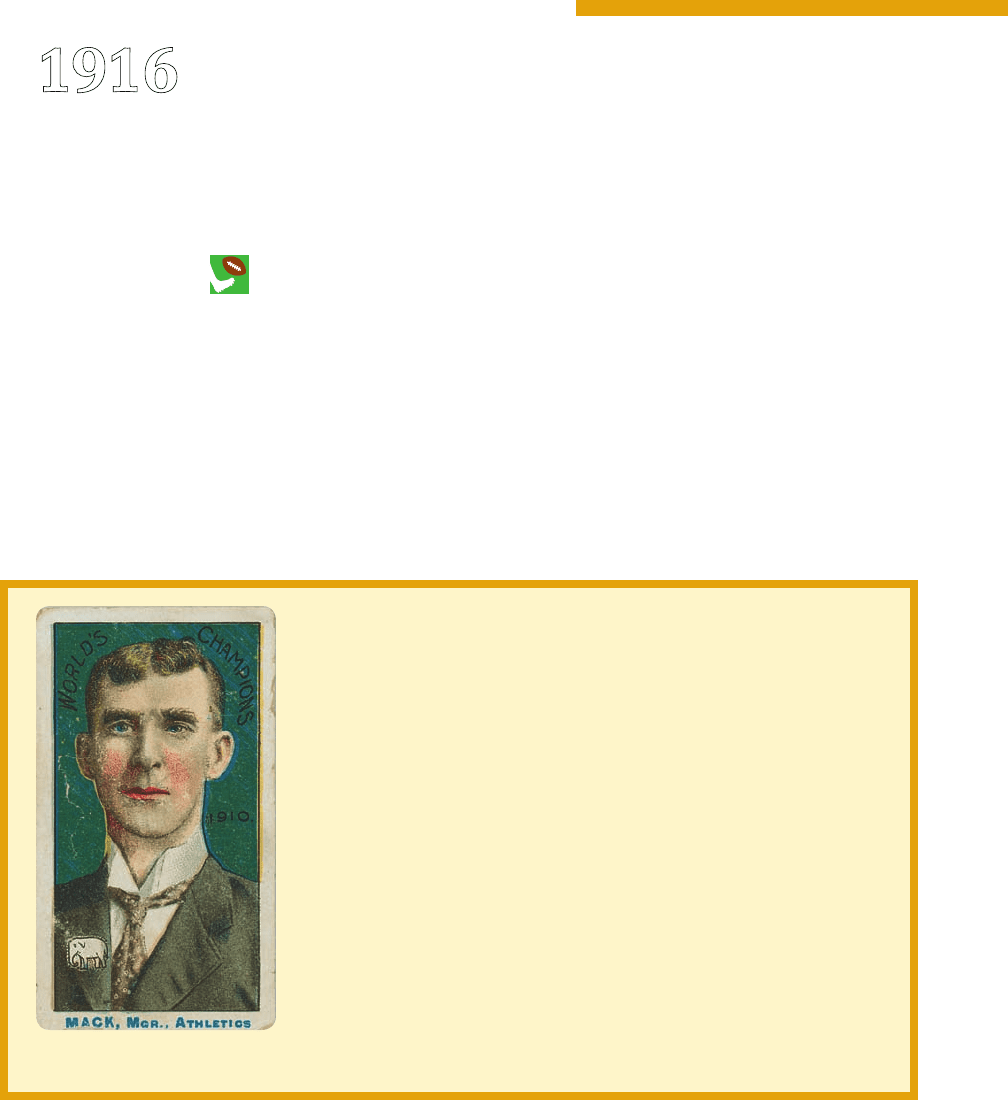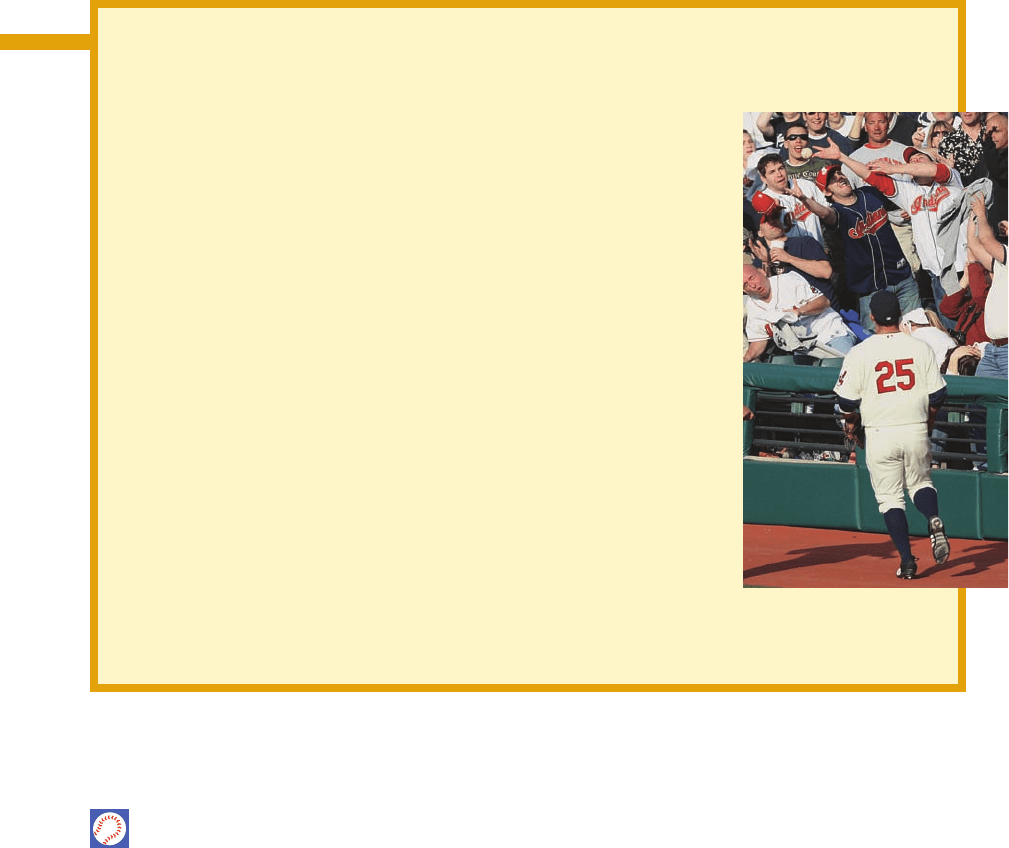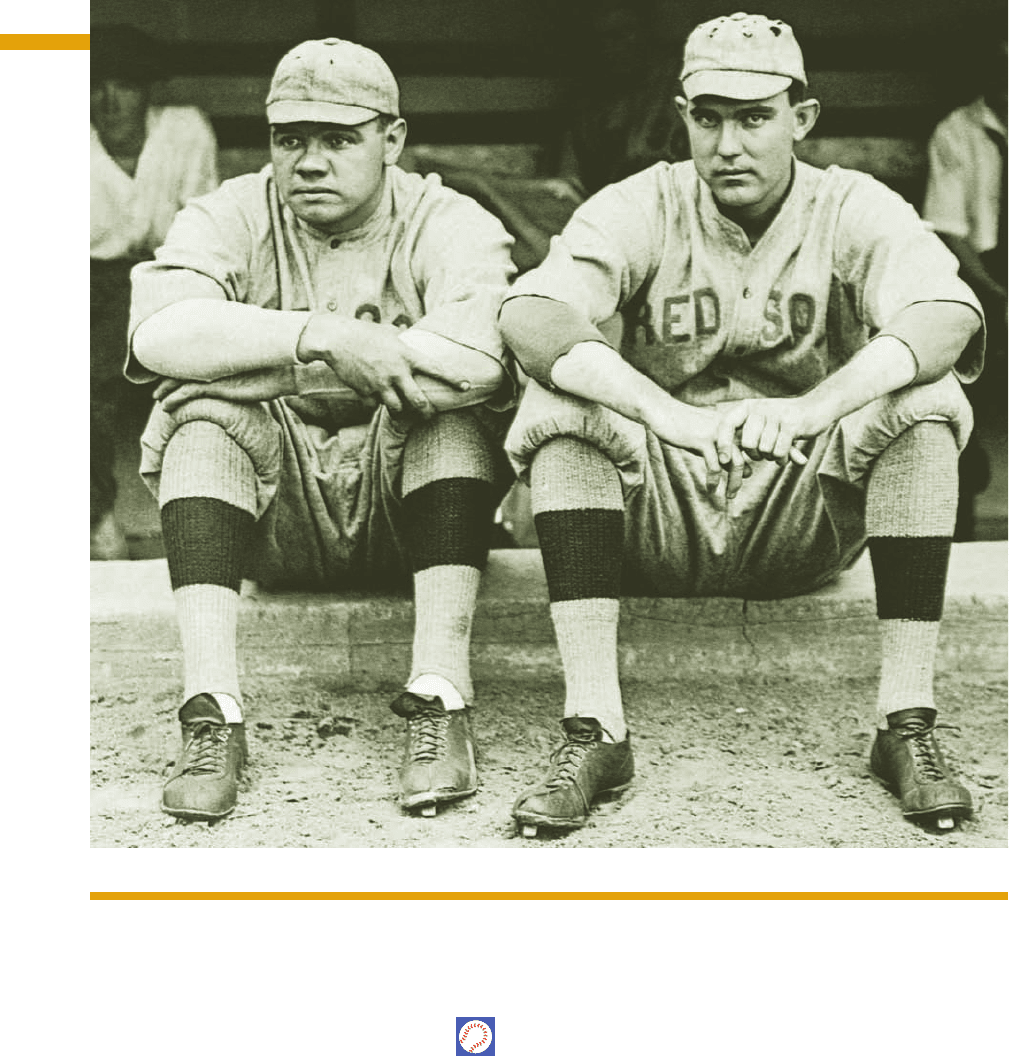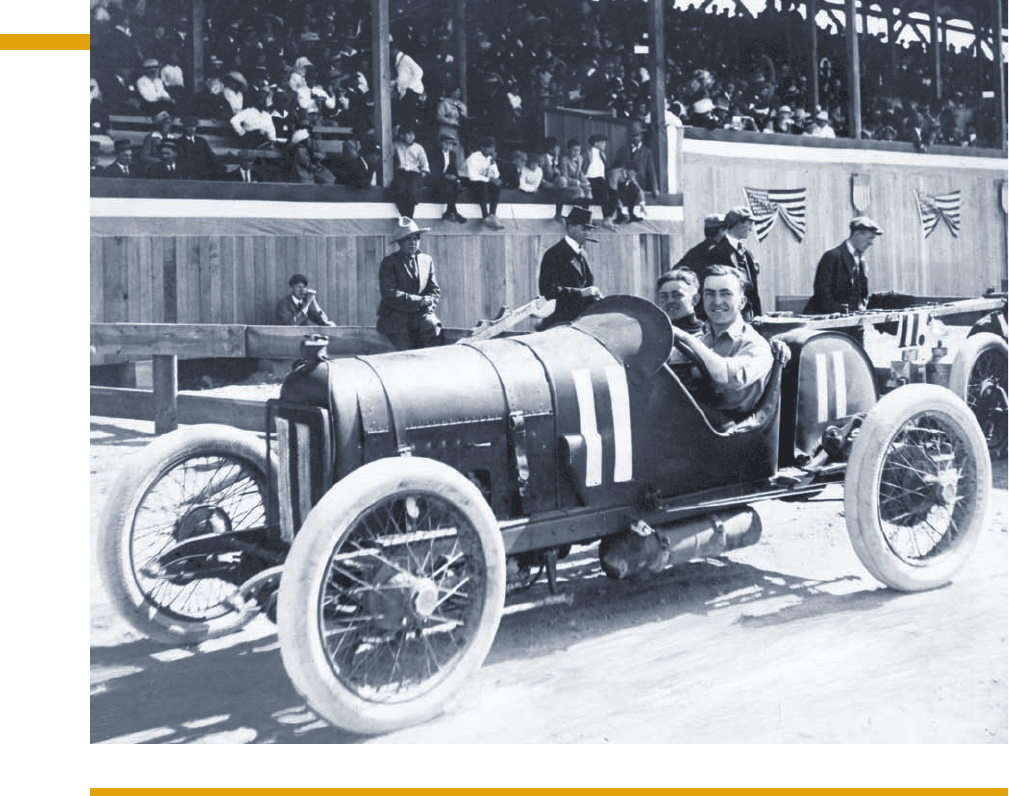Buckley James, Walters Jr. and John, Keith Larry. Sports in America: 1900-1919 (Sports in America: Decade by Decade)
Подождите немного. Документ загружается.


SPORTS IN AMERICA 1900–1919
as hundreds of young men went off to
serve their country once the United States
entered the war. Many athletes in differ-
ent sports saw their career interrupted by
events in Europe.
222–0
On October 7, Georgia Institute of
Technology defeated Cumberland
University in the greatest mismatch in
college football history. If the score, 222–0,
fails to convey Georgia Tech’s utter domi-
nance of the contest, consider this: Nei-
ther team had a first down. Cumberland
was too inept and Tech, coached by John
Heisman, scored every time that its of-
fense ran a play from scrimmage. For
Heisman (who now is much better known
for the trophy that is given in his name to
the best college football player of the
year), the game was a kind of revenge. The
previous spring, Cumberland’s baseball
team had spanked Tech, 22–0.
Cumberland discontinued football
in 1916. However, it had earlier agreed to
play Tech and honored the deal. The Leb-
anon, Tennessee, school sent 15 ill-pre-
pared players to Atlanta for the game, and
they were utterly outplayed. Their total
offensive output was minus 28 yards. How
bad was it? Late in the game a Cumber-
land fumble rolled toward Cumberland’s
B.F. Paty. “Pick it up!” the fumbler shouted
to Paty. “Pick it up yourself,” Paty replied.
“You dropped it.”
The game, mercifully, was halted with
15 minutes remaining.
90
A number of outstanding and peculiar Major League Baseball records were
set in 1916. Among them:
• The New York Giants won 26 consecutive games in September. However,
despite that streak and an earlier 17-game string, the Giants finished in
fourth place in the National League with an 86–66 record.
• The Philadelphia Athletics, winners of three World Series in six years under
manager Connie Mack, lost 20 consecutive games and finished in last place
(36–117) in the American League.
• On September 24, Marty Kavanagh of the Cleveland Indians belted the first
pinch-hit grand slam in American League history.
• Philadelphia Phillies pitcher Grover Cleveland Alexander pitched 16 shut-
outs on his way to leading the majors with a 33–12 record. Five of the 16
shutouts were against the Reds.
Baseball Records
Connie Mack

Red Sox Win—Again
The Boston Red Sox won their third
A.L. pennant in five seasons in 1916.
Their World Series opponent was the
Brooklyn Dodgers.
After Boston won the first game, it
sent star lefty Babe Ruth to the mound.
Before he was a slugger, Ruth was a ter-
rific pitcher. In 1916, the 21-year-old won
23 games and led the A.L. with a 1.75
ERA. He did not allow a home run during
the season.
In game two, Ruth allowed his first
homer of the season to Brooklyn’s leadoff
hitter Hy Myers. Ruth evened the score
himself two innings later, hitting into a
ground-out that scored a run.
For the next 10 innings, neither team
scored another run. Finally, in the bottom
of the 14th inning Red Sox pinch-hitter
Del Gainor singled in Mike McNally from
second base for the 2–1 victory. Ruth, after
allowing the leadoff homer, had pitched
14 innings of shutout ball (he later ex-
tended that mark to a Series-record 29
2/3 innings across three Series).
The Red Sox, up 2–0 in the Series,
eventually won four games to one to
capture back-to-back World Series titles.
91
✔ Although the formation of the National Hockey League was still two years
away, the Montreal Canadiens won their first Stanley Cup, three games to
two, over the Portland Rosebuds, on March 30.
✔ On June 26, baseball’s Cleveland Indians, in a 2–0 win against the Chicago
White Sox, wore numbers pinned to their sleeves, thus becoming the first
baseball team to have uniform numbers. At that time, a player’s number cor-
responded to his position in the batting order—so the number could change
as the batting order changed.
✔ A new major golf championship was born in October in Bronxville, New York:
The Professional Golfers Association (PGA) Championship. Pro golfers were just
beginning to gain popularity in a sport still dominated by amateurs. England’s
“Long Jim“ Barnes was the first winner of the PGA’s Wanamaker Trophy.
✔ Chicago Cubs owner Charles Weeghman introduced a baseball innova-
tion that remains popular today: Fans were allowed to keep baseballs that
are hit into the stands.
✔ Forty women competed in the first Women’s National Bowling Association
Tournament (now the Women’s International Bowling Congress Champion-
ship Tournament) on November 27 and 28 at Washington Bowling Alleys and
Billiard Parlors in St. Louis. Agnes Koester of Detroit was the winner.
Other Milestones of 1916
Fans chase after a
foul-ball souvenir.

1917
tries. The United States joined on the side
of Great Britain, France, Russia, Belgium,
Italy, Japan, and other allies to defeat Ger-
many, Austria-Hungary, Turkey, and Bul-
garia. The entrance of the U.S. into this
battle made it the first World War, also
called The Great War.
The war exacted a toll on every aspect
of American life, including sports. In 1917
a number of major sporting events were
canceled, and athletes decided whether
or not to enlist with the armed forces.
The annual Indianapolis 500 auto race
was canceled. In golf the U.S. Open and
the PGA Championship were canceled.
All boxing titles were frozen during the
next two years.
College football, if not the first casu-
alty of the war among American sports,
certainly suffered the most in 1917. No
All-America teams were selected. Some
major college football programs, among
them the University of Georgia, Univer-
sity of North Carolina, and University of
Tennessee, did not field teams, as so many
of their players joined the Army. The Rose
Bowl that capped the college season on
January 1, 1918, resembled a military en-
gagement as the Mare Island Marines
defeated Camp Lewis Army, 19–7.
United States Enters
World War I
On April 6, the United States Senate
and House of Representatives voted
overwhelmingly to declare war on Ger-
many. The United States had formally
entered a war that was sparked in 1914
after Archduke Franz Ferdinand, heir to
the throne of the Austro-Hungarian Em-
pire, was assassinated in Sarajevo, then a
part of Russia. When Austria-Hungary
declared war on Russia, Germany joined
in against Russia, igniting a skirmish that
spread among European and Asian coun-
92
Soldiers at Play This postcard shows U.S. soldiers playing baseball
at a training camp in Michigan in 1917.

Exactly seven months earlier, many
Americans realized that sports would not
be immune to the war. On June 1, Boston
Braves catcher Hank Gowdy, a hero of
the 1914 World Series, enlisted with the
Ohio National Guard. He became the first
Major League Baseball player to enlist in
the armed forces.
Ernie Shore’s Perfect
Game
One of the strangest perfect games
in baseball—no hits, no walks, no
errors, no hit batsmen, just 27 batters up,
27 down—began with a player later
known almost exclusively for his hitting:
What a Relief! Boston’s Ernie Shore (right) was perfect after taking over for Babe Ruth (left) against Washington.
93

SPORTS IN AMERICA 1900–1919
Babe Ruth. On June 23, Ruth took the
mound for the Boston Red Sox in the first
game of a doubleheader against the
Washington Senators at Boston’s Fenway
Park. Ruth must have been in an bad
mood that afternoon. His first pitch to
Senators leadoff batter Ray Morgan was
called a ball. Ruth did not like the call, and
left the mound to argue with umpire Brick
Owens. His second and third pitches were
also called balls, and after each one Ruth
barked his disapproval at Owens.
Ruth’s fourth pitch was called ball
four. Ruth went berserk. He approached
home plate and socked Owens in the jaw.
For that, Ruth was ejected from the game
(and was suspended for nine days and
fined $100).
Enter Red Sox teammate Ernie Shore.
A starting pitcher who had won one game
in each of the previous two World Series
for Boston, Shore came in to take over
for Ruth. After getting in his warm-up
pitches, he promptly picked Morgan off
first base. One out. From there Shore was
simply perfect. He faced 26 Washington
batters and retired each one of them, as
the Red Sox won 4–0. No Senators batters
reached base after Morgan. Including his
pickoff, it was 27 up, 27 down.
Was it a perfect game? For years
baseball said it was, since Shore entered
the game before one out had been re-
corded. Finally, in 1990 baseball reversed
the judgment on Shore’s “perfect game.”
The new rule said that for a pitcher to
pitch a perfect game, he must start and
finish it.
Giants Lose Series Again
No baseball team provided more
heartbreak during the decade than
the New York Giants. Manager John
McGraw had taken the team to the World
Series in 1911, 1912, and 1913 and lost all
three times. In 1917, the outcome was the
same. The Giants lost the World Series
that October in six games to the Chicago
White Sox. Pitcher Red Faber, a spitballer,
was the White Sox star, winning games
94
Red, White, and Baseball Despite the looming World War, the
1917 baseball season was played. This World Series program shows
Pres. Woodrow Wilson throwing out the first ball on Opening Day.

one, five (he pitched two innings of relief),
and six.
Game six was another tale of heart-
break for Giant fans. With no score in the
fourth inning at New York’s Polo Grounds,
Chicago’s Eddie Collins reached on an
error. The next batter, “Shoeless” Joe Jack-
son, hit a pop-up that Giant rightfielder
Dave Robertson dropped. Runners on
first and third, no outs.
Happy Felsch then grounded back
to the Giants pitcher, Rube Benton, who
noticed that Collins had strayed too far
off third base. Benton tossed the ball to
Zimmerman, the third baseman. Collins
sprinted home, past catcher Bill Rariden
who had carelessly walked away from
home plate. Zimmerman raced Collins
home. Collins slid safely before Zimmer-
man could tag him. The White Sox won
this game, and the Series, 4–2.
The NHL Is Born
On November 26 a meeting took
place inside Montreal’s Windsor
Hotel. Earlier in the year the National
Hockey Association (founded in 1909) had
decided to reorganize. Five of those
teams—the Ottawa Senators, Montreal
Wanderers, Montreal Canadiens, Toronto
Arenas, and Quebec Bulldogs—met to
form a new hockey league. They called it
the National Hockey League (NHL).
Before the season even began, the
Quebec Bulldogs opted not to field a team.
Too many Bulldogs skaters had joined the
armed forces. The new league cobbled to-
gether a short schedule of only 22 games
per team. Finally, on December 19, the
NHL opened play with a pair of games
in Montreal that were played in front of
only 700 fans.
The league champion would be
awarded the Stanley Cup, which was
already the goal for earlier pro hockey
leagues in Canada. The first U.S.-based
member of the NHL was Boston. The
Bruins joined the league in 1924.
95
✔ On March 26 the Seattle Metropolitans of the Pacific Coast
Hockey Association became the first U.S.-based team to win
the Stanley Cup. The Metropolitans beat the Montreal Cana-
diens, three games to one.
✔ On May 2 at Chicago’s Weeghman Park, 3,500 fans wit-
nessed baseball’s first double nine-inning no-hitter. Righthander
Fred Toney pitched for the visiting Cincinnati Reds while James
“Hippo” Vaughn, a southpaw, was on the mound for the Cubs.
Neither pitcher surrendered a hit through nine innings. The Reds
won in the 10th inning as Jim Thorpe—yes, that Jim Thorpe—got
the game-winning hit on a swinging bunt. Toney retired the Cubs
in order in the bottom of the 10th to preserve his no-hitter.
✔ On May 28, lightweight Benny Leonard beat Freddie Welso
to capture the world title. He retained the title for more than
seven years. In all, he won 86 of his 92 fights and earned a
reputation as one of the greatest ever in his weight division.
✔ On August 17, Gertrude Ederle, a 12-year-old swimmer,
zipped through the women’s 880-yard freestyle event in 13
minutes, 19 seconds at a meet in Indianapolis, Indiana, be-
coming the youngest person ever to set a world record. Nine
years later, she attempted to swim the English Channel.
✔ Henry Hall ski jumped a U.S.-record 203 feet at Steamboat
Springs, Colorado. Hall was the first to jump over 200 feet,
breaking the previous mark by 11 feet.
Other Milestones
of 1917

1918
was the creation of Daylight Savings Time
(so there were more hours of daylight for
war-production work). It proved to be
such a good idea that it was retained after
the war.
Of less lasting importance—but of
more importance to this story—was the
war’s impact on sports.
College football continued to be hard-
est hit. Military football squads sprouted
up in 1917 and 1918 as many college foot-
ball teams were discontinued. More than
20 schools eliminated football this year,
among them former national champions
Cornell University and Yale.
In July, Major League Baseball voted
to shorten its season from 154 games to
125. The regular season ended a month
early, on September 2. The World Series
was allowed to be staged, ruled Secretary
of War Newton D. Baker, as long as 10
percent of its revenues were given to war
charities. The players received all-time
lows in winner’s and loser’s shares. The
winner’s share was $1,102 per man.
The most famous athletes, such as
boxer Jack Dempsey and slugger Babe
Ruth, were not called to war. They were
allowed to continue entertaining Ameri-
can citizens who were working hard at
Over There!
What started as a trickle in 1917 be-
came a flood in 1918. World War I
was raging in Europe, and more and more
Americans headed “over there,” as a pop-
ular song went. The war affected many
parts of American life. One lasting effect
96
Tragic End Princeton’s Hobey Baker was
one of thousands of young men who went
to war—but Baker never came home.

home to support the war effort overseas.
Other patriotic athletes, such as pitcher
Christy Mathewson and Indy 500 racer
Edward Rickenbacker, decided to enlist
anyway. Rickenbacker earned far more
fame as the United States’ top flying ace
than he ever had in four races at Indy.
The “Ace of Aces,” as Rickenbacker was
known, shot down 26 enemy aircraft over
the skies of Europe.
Others were not so lucky. Mathew-
son trained as an officer in the Chemi-
cal Corps, learning about gases used by
enemy forces. During training, Mathew-
son inhaled some of the gases and even-
tually led to this death in 1925 at the
age of only 45. Hobey Baker, who had
been captain of Princeton University’s
football and hockey teams, and who flew
with Rickenbacker’s squadron, was killed
while test-piloting an aircraft in France.
His name lives on today—the nation’s top
college hockey player is given the Hobey
Baker Award.
War Hero Race car driver Edward Rickenbacker also earned considerable acclaim as a World War I flying ace.
97

SPORTS IN AMERICA 1900–1919
Some athletes went to war. Some
stayed home. Others did both. Future
baseball Hall of Famer Rabbit Maran-
ville joined the Navy. Then in July he
was granted a 10-day leave. The infielder
headed straight to his old team, the Bos-
ton Braves. Maranville batted .316 in 11
games before returning to sea.
Red Sox Beat Cubs in
World Series
Both the Boston Red Sox and the
Chicago Cubs made their fifth World
Series appearance in 1918. Boston, which
had won all four World Series in which it
had played, was Major League Baseball’s
most successful postseason franchise. Of
course, that was true only through 1918.
Later events would prove that Boston and
the Cubs would not enjoy Series success
for decades—if ever.
Babe Ruth, who won 13 games dur-
ing the regular season, outdueled the
Cubs’ 22-game winner, Hippo Vaughn,
in Game 1, 1–0. Ruth’s complete-game
shutout, added to his 13 scoreless innings
in the 1916 World Series, gave him 22
consecutive scoreless innings pitched in
the Series. By the end of this Series, his
record had reached 29 straight, a mark
that would stand for more than 40 years.
Another highlight of the opener: Dur-
ing the seventh-inning stretch a military
band played “The Star-Spangled Banner,”
which was not yet the National Anthem
(that did not happen until 1931). From
then on the song has been played at every
World Series game.
Chicago kept it close, but Boston
ended up winning the title in six games.
The Series was a defensive gem. The
Red Sox batted just .186, the all-time low
for a World Series winner (the Cubs hit
.210), but only committed one error (also
a record for a six-game World Series).
No team ever scored more than three runs
in one game. No home runs were hit.
Toronto Arenas Are First
NHL Champs
The first National Hockey League
season began on December 19, 1917,
with four teams: the Montreal Canadiens,
Montreal Wanderers, Ottawa Senators
and Toronto Arenas. Two weeks later, only
three teams remained.
On January 3, Montreal’s Westmount
Arena, the home ice of both the Cana-
diens and the Wanderers, was destroyed
by a fire. The Wanderers, already short-
handed due to the war, chose to cancel
their season.
The infant hockey league played
on, scheduling a 22-game season in two
halves. The winner of the first half would
play the winner of the second half for the
NHL title. The winner would then advance
to play the Pacific Coast Hockey Associa-
tion (PCHA) champ for the Stanley Cup.
Montreal defeated Toronto 10–9 in
the first NHL game ever played. The Ca-
nadiens went on to win the season’s first
half. Toronto won the second half of the
season, then outlasted the Canadiens
during the two-game playoff, 10 goals
to 7. The Arenas met the Vancouver Mil-
lionaires and their high-scoring forward,
Cyclone Taylor, in a best-of-five series
for the Stanley Cup in March. After split-
ting the first four games, Toronto won
98

the clincher, 2–1. For the first time, an
NHL team won the Stanley Cup. More
importantly, the new league survived a
tumultuous first season.
Magical Molla Bjurstedt
Molla Bjurstedt was a tennis legend
in her native Norway. By the age of
21, Bjurstedt had already won eight Nor-
wegian national championships. In 1914,
she sailed to New York to visit relatives.
She liked it there so much that she de-
cided to stay. Women’s tennis history
changed as a result.
A year later, Bjurstedt attended the
men’s national indoor tournament in New
York as a spectator. But when she learned
there was a women’s competition, she
entered—and won.
For the next four years Bjurstedt
dominated tennis in her adopted country.
She won the U.S. Open on the grass courts
of the Philadelphia Cricket Club four
straight years, from 1915 to 1918. Her final
victory in the streak, on June 22, came at
the expense of Eleanor Goss, 6–4, 6–3.
Also in 1918, Bjurstedt won her third
U.S. indoor singles title in September. The
following year Bjurstedt married Ameri-
can Franklin Mallory. As Molla Bjurstedt
Mallory she won four more U.S. Open sin-
gles titles, the last at age 42 in 1926 (still
the oldest women’s major champion). Her
eight singles crowns at the Open remains
the women’s record.
99
✔ On May 14, lawmakers in Washing-
ton, D.C. made it legal to play baseball
on Sundays. The populations of major
cities were increasing with soldiers re-
turning from the war, and lawmakers
wanted to provide these working peo-
ple with recreation and amusement.
✔ African-American end Paul Robe-
son of Rutgers University, the son of a
slave, was named an All-American and
graduated as the school’s valedictorian.
Robeson later went on to become a
lawyer, acclaimed actor, singer, and civil
rights activist.
✔ Heavyweight boxing contender
Jack Dempsey won 15 of 16 bouts in
1918 and avenged a 1917 knockout by
“Fireman” Jim Flynn (the only knock-
out in Dempsey’s entire career) with
a Valentine’s Day first-round knockout
of Flynn. Dempsey’s other first-round
victims included Fred Fulton (after only
18 seconds of fighting) and Carl Morris
(after 14 seconds).
Other Milestones of 1918
Paul Robeson
